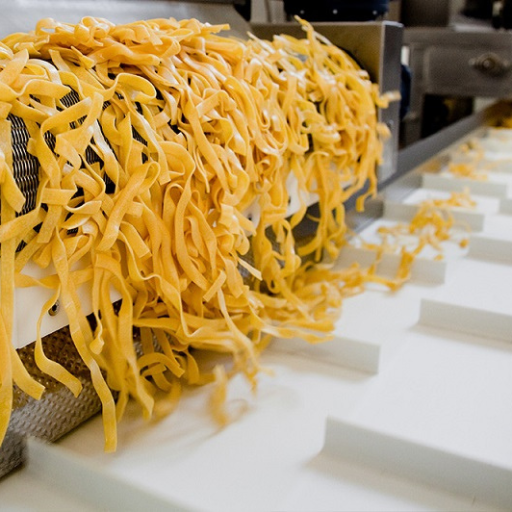The world of dry pasta production is a fascinating journey that travels from the rustic kitchens of Italy to the high-tech factories that churn out millions of pounds of pasta each year. This blog aims to explore the intricate process of producing dry pasta, highlighting the centuries-old traditions upheld by Italian pasta makers and the innovations introduced by modern technology. We will delve into the different stages of pasta production, from selecting high-quality durum wheat semolina to the drying techniques that preserve its unique texture and flavor. Additionally, we’ll examine the current market trends, consumer preferences, and how evolving dietary habits are shaping the pasta industry. By the end, readers will gain a comprehensive understanding of the delicate balance between preserving authenticity and embracing innovation in the world of dry pasta production.
How is Dry Pasta Produced?
Raw Materials for Pasta Production
The primary raw material used in making dry pasta is durum wheat semolina. This type of grain which has been ground coarsely is preferred because of its high protein content and ability to withstand gluten action. This is what gives cooked pasta firmness and allows it to retain its shape. Besides durum wheat semolina, another key ingredient that helps hydrate the semolina so it can be turned into dough is water. There are also some special varieties of pasta that have other ingredients besides those mentioned above such as vegetables puree, spices or eggs for taste enhancement purposes. However, traditional plain pasta depends entirely on uncomplicated but quality durum wheat semolina mixed with water.
Semolina in Pasta Dough
Due to its rough texture and high levels of gluten, which provide the stiffness and stretchiness required for dry pasta, Semolina essential to the dough composition. Semolina’s gluten network provides the structure during cooking thus preventing mushiness from occurring while boiling. Further, carotenoids found in the semolina give a good yellow coloration to this product. Hence, hard texture plus beautiful color among others make traditional pasta different from any other hence being defined by semolina as the most suitable ingredient for quality products.
Starting Pasta Production: Mixing and Kneading
The process starts with mixing and kneading which are crucial stages in pasta production process respectively. Durum wheat semolina plus water are first incorporated in precise ratios when mixing starts off initially. Water makes it possible for Semolina particles to absorb sufficient moisture turning them into elastic doughs that easily knead through large industrial mixers in these facilities afterwards. Final product’s texture mainly depends on a development of gluten network through kneading stage which largely determines how smooth or elastic it will be when ready i.e., after boiling has taken place (Roughly speaking). The dough should be subjected enough kneading until it attains proper consistency, smoothness and elasticity that guarantees it to neither stick together nor get too soft when it is cooked. Consequently, since different pasta types may be prepared in this process eggs or vegetable purees are some of the extras added at this level to improve taste and appearance.
What are the Steps in the Drying Process of Pasta?
Understanding the Drying Cycle in Pasta Processing
Pasta drying process is a very important phase of pasta manufacturing as it has a significant effect on the final quality and shelf life of the pasta. Some of the steps involved in this process are:
- Pre-Drying: The freshly shaped pasta, is first pre-dried by exposing it to warm air for a short period. This step serves to stabilize the surface of the pasta and reduce its moisture content slightly so that pieces do not stick together.
- Primary Drying: Then, in primary drying, which takes place in drying chambers, the moisture is slowly evaporated from the pasta at controlled temperatures and humidity levels. It is during this phase that cracks are avoided while ensuring uniformity throughout.
- Final Drying: It reaches up to 12-13% when it comes to moisture contents through exposure to various temperature patterns like starting with high temperatures then gradually reducing them or rather lower ones and increased time for drying among others. By doing this, therefore, brittle products will never be made but rather complete dryness will be attained.
Every stage of the drying procedure is carefully monitored so as to maintain integrity and quality of finished product. Depending on what type and thickness of pasta is being handled, the entire cycle can last anywhere between several hours to an entire day.
High Temperature vs Low Temperature Drying
There are two main types of drying methods used for drying pastas namely high-temperature drying method or low temperature- drying method each having their own merits and demerits.
High-Temperature Drying:
- Speed: This reduces substantially time spent on drying hence shortening production cycles. Mostly, high temperature drying ranges from around 70°C (158°F) to 90°C (194°F).
- Efficiency: This keeps shape as well as surface quality which reduces chances that microorganisms transgress into them.
- Quality Impact: However sometimes high temperature could lead some effects such as slight alteration in flavor and texture of pasta. The rapid drying can cause the starches to gelatinize unevenly, potentially affecting the final product’s taste and structural integrity.
Low-Temperature Drying:
- Flavour and Texture: In terms of flavor and texture, this traditional method is considered to be better than high temperature drying. For example, a constant drying temperature range from 40°C (104°F) to 60°C (140°F) results in slow uniform loss of moisture from the pasta.
- Quality & Nutritional Value: It also helps retain more nutrients during its gradual drying as well as keeping its shape intact.
- Time-Consuming: However, it is a time consuming method that might take several days or up to 24 hours depending on type and thickness of pasta being used. This technique suits mostly artisanal or speciality pastas.
However, which method is chosen depends on desired quality attributes for the final product, production capacity and specific processing goals.
Drying and its relationship with the moisture content in pasta
During drying, moisture content is an important factor that affects both quality and safety characteristics of pasta. To prevent mold growth on a product, you must control its moisture levels as well as to extend the shelf-life. The fact that the pasta has satisfactory texture and cooking properties can be attributed to appropriate moisture management; excessive humidity makes it gummy while insufficient amounts will result in fragile or crumbly noodles. Therefore, attaining desirable levels of water plays a significant role in striking the right balance between durability and palatability for better quality and acceptance by consumers.
How Does an Italian Pasta Factory Operate?
Typical Pasta Production Line Overview
In a typical pasta production line, there are several well-defined stages that convert raw materials into finished pasta:
- Ingredient mixing: First, durum wheat semolina and water are mixed. The dough is uniformly blended in fast mixers.
- Dough kneading: Gluten that gives the pasta a firm texture is developed when the mixed dough is kneaded.
- Extrusion: The dough that has been already kneaded is forced through different dies to create spaghetti, penne or fusilli among other kinds of pasta shapes. This also involves vacuuming machines to get rid of air bubbles during extrusion.
- Drying: Depending on the quality and kind of pasta desired, it will either be dried at high temperatures or low temperatures. This step determines its overall texture and shelf life.
- Cooling: Then slowly cooled so that no cracks or brittleness develop on its surface.
- Packaging: After drying and cooling, the product can be bagged in bags or boxed for distribution. Automated systems weigh the packaging as well as fill it in order to provide uniformity.
- Quality Control: Throughout all production stages, various checks are conducted to determine whether pasta is up to required standards regarding its feel on touch, amount of moisture absorbed and outline.
These steps shown how detailed one needs to be when producing best tasting pastas like those produced in Italian macaroni factory.
The Role of Extruders in Shaping Pasta
To form different types of pasta shapes they have extruders pushing molds against kneaded dough. Such process called extrusion helps give rise to different forms of what we now see with us as species like spaghetti, panne or fusilli among many others. This precision ensures evenness in shape and size for each piece which makes their cooking time consistent hence their quality. Moreover, vacuum systems can be incorporated into these extruders thereby eliminating air pockets from the mixture thus improving both its structure and texture.
Ensuring Pasta Quality in Each Production Stage
To deliver a high-quality finished product, it is important to ensure that pasta quality at every stage of production. According to reputable information sources like Barilla, good raw materials must be focused on. Selecting best durum wheat which semolina will be carefully ground for making dough is the first step here. For instance, extrusion and drying processes have to be closely monitored; hence, Barilla sticks to sophisticated extrusion technologies helping to maintain uniformity and minimize possible defects. During drying, temperature as well as humidity are strictly maintained so as to reach the desired texture and durability. Automated systems confirm weight while examining for blemishes during packaging stage too. The moisture content must therefore be thoroughly tested at various points until final product is achieved because consumers always deserve only the very best!
What Makes Artisan Dry Pasta Different?
How artisan dry pasta is produced
Artisan dry pasta is characterized by the use of traditional and meticulous production methods. This, unlike industrial pasta that is made in masses, artisans pasta are often produced in small-batches with the use of bronze dies instead of Teflon dies. As a result, on the surface of such pastas there is a rougher texture that enhances absorption of sauce. Normally dough is prepared by slowly mixing high-quality semolina and water so as to obtain the right consistency. On another note, slow drying which might take several days at low temperatures are usually undertaken during the drying process. Because it takes longer for such dried pastas to lose all their moisture content than other types does, they preserve flavor and nutritional value better. These techniques used by leading makers like LOYAL, Rustichella d’Abruzzo and Semolina Artisanal Pasta ensure that each batch has its own unique qualities.
The distinctiveness of artisan pasta
Artisan noodles and pastas have been widely acknowledged because they stand out from other types which are produced commercially by a few traits: firstly, these noodles have coarse surfaces since they were shaped with bronze dies; therefore they present absorbent surfaces for all kind of sauces Secondly, through this slow drying process at low temperature most Italian dried pasta has evolved giving rise to better taste as well as increased health benefits because its natural flavors and nutritional content are retained Finally various raw materials including high quality semolina or whole grains can be used for each batch hence guaranteeing that every product offered is authentic and tasty in contrast to many mass-produced options available on the market. These characteristics make artisanal noodles highly desirable among gourmet aficionados who appreciate both fine foodstuffs and long-established practices.
Why Artisan Pasta Matters In Italian Cuisine
Artisanal noodles contribute positively to the richness of Italian cooking as an authentic experience.Firstly it fits into dishes better due to a superior texture that is achieved through traditional methods of extrusion and slow drying with bronze dies. Secondly, higher nutritional value and fuller taste due to the use of more qualitative ingredients, such as semolina or whole-grain flour, instead of the cheaper ones usually used for industrial pasta production. Lastly, the artisanal producers who follow ancient traditions have managed to preserve their authentic cultural heritage connected with Italian pasta manufacture; therefore, their meals are really unique and delightful making a significant contribution into Italy’s rich cuisine. All these features make artisan pastas popular among cooks and gourmets who always strive to create an original Italian dish.
Can You Make Gluten-Free Pasta Using Traditional Methods?
Gluten-Free Pasta Manufacturing
Sure, you can make gluten-free pasta using conventional techniques. This can be achieved by replacing wheat-based flours with gluten-free ones such as rice flour, corn flour, or a mixture of gluten-free grains which produces pasta that feels and tastes very closely to traditional pasta. The secret lies in employing the same artisanal processes like slow drying and bronze-die extrusion for robustness in texture and enhanced sauce holding ability of the pasta. Hence, the ratios and processes are not exact and require some experimentation however quality and tradition are relied on to ensure that gluten-free pasta is just as satisfying and tasty as its counterpart made from wheat.
The Challenge of Managing Gluten Free Pasta Without Gluten
Managing gluten free pasta without this substance is quite difficult but it’s possible to achieve it. Firstly, the texture resulting from gluten’s presence in dough makes it stretchy and rubbery; hence, making an imitation with other ingredients devoid of it requires careful selection and blending of alternative flours like rice corn quinoa etc. Slow drying according to their traditional manner helps improve the overall quality of these kinds of pastas in terms of their textures. Besides this they have to be able to hold sauces well thus bronze-die extrusion creates a porous surface on the pasta itself . Nevertheless patience together with experiments must go hand in hand while observing these steps one can make a type of non-gluten variety that has same taste buds satisfaction & viscosity qualities similar to those found within ordinary wheat kind.
Optimizing Production Conditions for Gluten-Free Pasta
Optimizing production conditions for gluten-free pasta is not a one-size-fits-all approach. In my experience optimizing moisture content is crucial; therefore regulating it appropriately determines the balance between flexibility as well as firmness required. Controlling temperature throughout the process particularly during drying maintains textural consistency. Additionally combining high-quality gluten free flours including starches such as rice flour cornstarch xanthan gum mixture gives the pasta both chewiness and elasticity. For example it is by proper machine extrusion and drying techniques that a smooth surface should be created on the pasta which sticks to sauce like traditional pasta does. Also, high quality gluten-free pasta is achieved by updating equipment for accuracy and precision.
Frequently Asked Questions (FAQs)
Q: What determines pasta quality during its production?
A: Several factors determine the quality of pasta including type of semolina flour, processing conditions of mixings and kneading phase, and drying conditions applied. Also, the precision of extrusion and drying phase times affects the quality of pasta that all contributes to a final product.
Q: How does the drying process for pasta affect its nutritional quality?
A: Properly done pasta drying process helps in preserving nutritional value by minimizing nutrient loss and maintaining proteins’ structure in the pasta. Over-drying or wrong drying can lead to formation of undesirable textural properties with diminished nutritional value.
Q: What role do pasta manufacturers play in ensuring product quality?
A: To ensure good product quality, strict process conditions and fine ingredients have to be used by Pasta manufacturers. They ensure that right from selecting semolina flour to packing cooked Macaroni, there is no compromise on quality which has to meet industry standards.
Q: How are drying conditions related to appearance of Pasta?
A: Drying conditions determine the texture of Pasta. Optimum drying brings about bright even coloring and compactness while poor drying causes discolored or brittle noodles. During this stage uniformity in moisture removal helps shole short macaroni differ from spaghettis or long macaroni because it retains their visual appearances.
Q: Why is semolina flour commonly used in the production of pasta?
A: It is often made from hard wheat so as to make it firm enough such that it is able to retain its shape during cooking. Furthermore it contains proteins thus enable it make a firm dough without becoming mushy after cooking hence enhancing perceived goodness in any dish containing them.
Q: What are the differences between fresh pasta and dry pasta?
A: Fresh macaronis are eggs-based with more water content than dried ones thereby forcing them into refrigeration due to low shelf-life while dehydrated one produced from dough of semolina and water can be kept dry for a longer period. As opposed to fresh pasta, which has a softer texture when cooked, the drying process in dry pasta manufacturing makes it have a firmer texture.



















